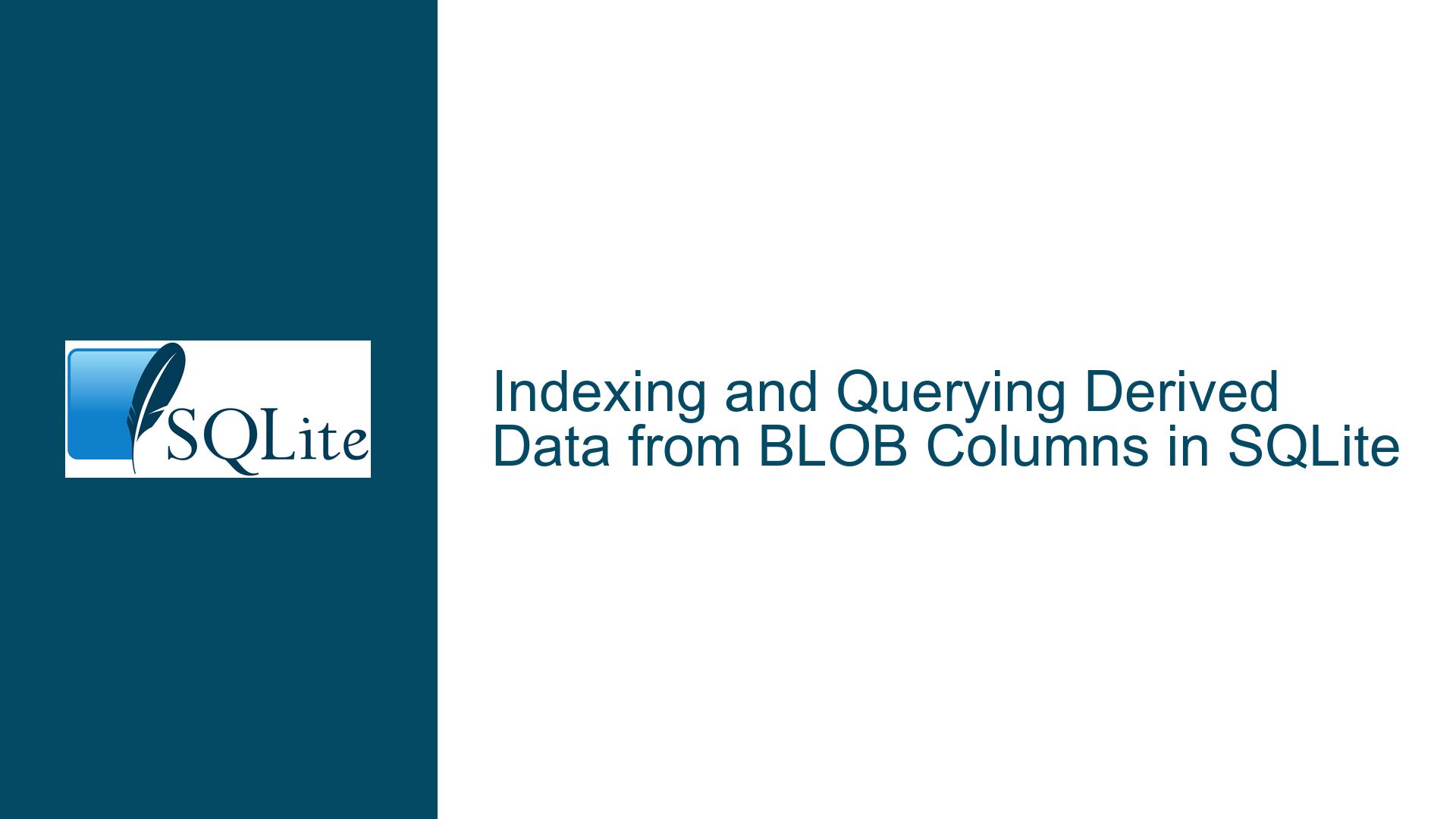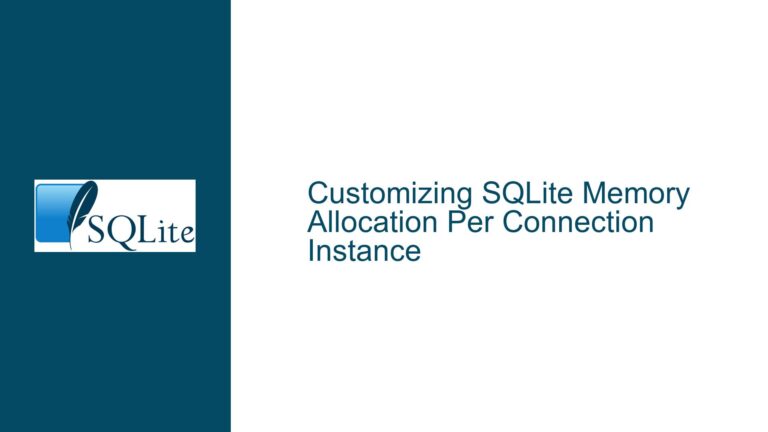Indexing and Querying Derived Data from BLOB Columns in SQLite
Extracting, Indexing, and Querying Transformed BLOB Data
Parsing Derived Attributes from Binary Data for Search and Sort Operations
The challenge revolves around making binary large object (BLOB) data searchable and sortable based on derived attributes that are not natively stored in the BLOB itself. For example, a BLOB may contain serialized "file alias data" that includes a file path alongside metadata for resolving the path if the file moves. While the raw BLOB is not directly usable for sorting or filtering by the resolved path, the requirement is to index and query based on this computed value. The core technical hurdle involves bridging the gap between the opaque binary format and the need to interact with parsed, human-readable attributes in SQL operations. This necessitates mechanisms to extract, materialize, and index derived values without duplicating or restructuring the original BLOB storage.
Constraints Imposed by BLOB Opacity and Deterministic Extraction
Three primary factors contribute to this problem. First, BLOBs lack intrinsic structure in SQLite. Unlike text or numeric columns, BLOBs are treated as undifferentiated binary streams. Any semantic meaning or internal structure within the BLOB is invisible to the SQL engine unless explicitly decoded. Second, derived attributes require computation that cannot be expressed natively in SQL. Extracting a resolved file path from a custom binary format might involve parsing byte offsets, decoding strings, or applying application-specific logic. Third, indexing demands determinism. For an index to remain consistent with the underlying data, the process of deriving the attribute from the BLOB must always produce the same output for identical input bytes. Non-deterministic computations (e.g., those relying on external state) cannot be used in indexes.
These constraints create a scenario where standard SQL indexing techniques are insufficient. Traditional indexes on BLOB columns would only operate on the raw bytes, not their interpreted content. Without a mechanism to project derived attributes into indexable columns or expressions, queries relying on those attributes would resort to full-table scans, extracting and filtering data row-by-row. This becomes prohibitively slow for large datasets. The solution space involves strategies to materialize derived attributes in ways compatible with SQLite’s indexing capabilities while maintaining synchronization with the source BLOBs.
Materialization via Generated Columns and Expression Indexes
1. Deterministic User-Defined Functions in Expression Indexes
If the derived attribute can be computed via a deterministic SQL function, create an index on the expression that invokes this function. SQLite allows indexes on arbitrary expressions provided they are deterministic. For example, if a user-defined function resolve_blob_path(blob) extracts the resolved path from the BLOB:
CREATE INDEX idx_resolved_path ON files(resolve_blob_path(blob_data));
Queries filtering or sorting by resolve_blob_path(blob_data) will leverage this index. Key requirements:
- The function must be registered with SQLite as deterministic using
sqlite3_create_function_v2()withSQLITE_DETERMINISTICflag. - The function must always return the same output for the same input BLOB.
- Consider performance: Frequent invocation of complex functions in indexes may impact insert/update speed.
2. Persisting Derived Attributes with Generated Columns
Create a virtual or stored generated column that holds the derived attribute. Virtual generated columns compute values on-the-fly during queries, while stored columns persist the data:
ALTER TABLE files ADD COLUMN resolved_path TEXT GENERATED ALWAYS AS (resolve_blob_path(blob_data)) VIRTUAL;
CREATE INDEX idx_resolved_path ON files(resolved_path);
Advantages:
- Virtual columns avoid storage overhead but recompute values during each query.
- Stored columns consume space but offer faster read performance.
- Indexes on generated columns behave like standard indexes.
3. Trigger-Based Synchronization for Non-Deterministic or External Logic
When derived attributes require non-deterministic operations or external processing (e.g., invoking a network service to resolve a path), use triggers to maintain a separate column:
ALTER TABLE files ADD COLUMN resolved_path TEXT;
CREATE TRIGGER tg_files_resolve_path AFTER INSERT ON files BEGIN
UPDATE files SET resolved_path = external_resolve_path(new.blob_data) WHERE rowid = new.rowid;
END;
-- Repeat for UPDATE events
This approach decouples the resolution logic from SQLite’s transactional guarantees, introducing eventual consistency. Ensure that external dependencies (e.g., network availability) do not compromise data integrity.
4. Virtual Tables for Complex Parsing and Join Operations
For scenarios requiring advanced parsing or integration with external data sources, implement a virtual table that exposes derived attributes as first-class columns. Using the sqlite3_module API, create a virtual table type that reads the BLOB, parses it, and surfaces the resolved path as a queryable column:
// Implement xBestIndex to push down predicates on resolved_path
// Implement xFilter to scan and parse BLOBs, applying filters
Virtual tables allow seamless integration of custom data processing into SQL operations but require significant development effort in C. They are ideal when derived attributes need to participate in joins or when the parsing logic is too complex for SQL functions.
5. Hybrid Approaches with Shadow Tables
Maintain a separate table that stores derived attributes linked to the original BLOB via foreign key. Use triggers or application logic to keep the shadow table synchronized:
CREATE TABLE files_resolved (
file_id INTEGER REFERENCES files(id),
resolved_path TEXT,
PRIMARY KEY(file_id)
);
This separates concerns and allows independent indexing but introduces join overhead in queries.
Optimization Considerations
- Covering Indexes: Include derived attributes and frequently accessed columns in the index to avoid table lookups.
- Collation Sequences: If sorting by derived attributes requires locale-aware comparisons, specify collations in indexes.
- Partial Indexes: When only a subset of BLOBs contain relevant data, use
WHEREclauses in indexes to reduce size. - Benchmarking: Compare the performance of virtual columns vs. triggers vs. materialized views under realistic loads.
Debugging Common Pitfalls
- Non-Deterministic Functions in Indexes: Verify that all functions used in indexes are marked deterministic. Test by altering function implementation and checking for index corruption.
- Trigger Overhead: Profile insert/update performance with triggers enabled. Batch operations may require temporary trigger disabling.
- Virtual Table Cost: Use
EXPLAIN QUERY PLANto verify that virtual table scans leverage pushed-down predicates. - Concurrency Issues: Ensure that external resolution in triggers or virtual tables handles concurrent access and locking appropriately.
Migration Strategies
When retrofitting existing tables:
- Add generated columns or shadow tables in schema migrations.
- Backfill derived attributes using batch updates.
- Gradually shift read queries to use new indexes, monitoring performance.
By systematically evaluating the complexity of attribute derivation, access patterns, and consistency requirements, developers can select the optimal strategy for making BLOB-derived data searchable and sortable in SQLite.






